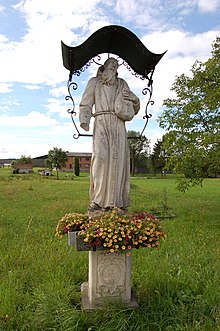Sparbach (municipality of Vitis)
|
Sparbach ( village ) locality cadastral community Sparbach |
||
|---|---|---|
|
|
||
| Basic data | ||
| Pole. District , state | Waidhofen an der Thaya (WT), Lower Austria | |
| Judicial district | Waidhofen an der Thaya | |
| Pole. local community | Vitis | |
| Coordinates | 48 ° 44 '52 " N , 15 ° 13' 4" E | |
| Residents of the village | 90 (January 1, 2020) | |
| Building status | 56 (2001) | |
| Area d. KG | 4.56 km² | |
| Statistical identification | ||
| Locality code | 06520 | |
| Cadastral parish number | 21185 | |
| Counting district / district | Sparbach (32219 005) | |
| Source: STAT : index of places ; BEV : GEONAM ; NÖGIS | ||
Sparbach is a cadastral community and a place in the market town of Vitis , Waidhofen an der Thaya district . In 2001 the place had a population of 99 people.
location
The cadastral municipality Sparbach is located in the southeast of the municipality of Vitis and borders in the south on the municipality and cadastral municipality Echsenbach , in the east on the municipality Schwarzenau (cadastral communities Schwarzenau and Modlisch ) and in the north on the municipality Windigsteig (cadastral municipality Kleinreichenbach ). In addition, the Sparbach cadastral community has borders with the Vitiser cadastral communities Vitis (with the localities Schacherdorf and Schoberdorf ) in the west and Kaltenbach in the southwest.
The cadastral municipality of Sparbach extends in the north to the Schacherwald and extends in the southwest to the German Thaya . In the northern area, the cadastral community is cut through by Waldviertler Straße (B 2), with Sparbach located south of the main road. The village of Sparbach is a lenticular village that extends from Waldviertler Straße to the southwest. In addition, some buildings near the Thaya belong to Sparbach.
history
Population development

|
The place name Sparbach is first documented by a document from 1376, in which the sale of a tenth to Sparbach by Peter Ohaim to Wolfahrt Strein zu Schwarzenau was notarized. The name Sparbach is traced back to the accumulated occurrence of sparrows in a stream.
Sparbach originally belonged to the Schwarzenau lordship with land, village and regional courts. In 1633 it consisted of 17 feudal houses and 11 farmsteads, and the "Rambhartsmüll" and the "Klokhen-Müll" belonged to Sparbach. The place was part of the parish of Großhaselbach until 1759 and was only then parish to Vitis. Three years earlier, in 1756, the chapel in Sparbach was built, the way chapel on the main road dates from the 19th century.
The number of houses in Sparbach has hardly changed over the centuries. While there were 29 houses in Sparbach in 1590/91, their number had only increased to 31 houses by 1900. Only then did Sparbach grow stronger. In 1951 there were 36 houses, in 2000 the place consisted of 42 houses. Simultaneously with the growth of the houses, however, the population fell massively. While around 200 people had previously lived in Sparbach for a long time, the population had reduced to 99 by 2001.
In 1928 Sparbach still had two mills on the Thaya , a blacksmith, a general store, a cement manufacturer and an inn. However, large parts of this original infrastructure have now disappeared. In the political field, the Austrian People's Party (ÖVP) dominates the election results, analogous to the municipal level. The ÖVP in the Sparbach electoral district achieved 78% (community result: 70%) and the Social Democratic Party of Austria (SPÖ) 22.0% (community result: 30%) in the 2010 local council election .
Buildings
The place Sparbach is mainly composed of three and four-sided courtyards, which have mostly simple plastered facades from the 19th century. The Sparbach chapel was built after 1909 and is a historicist, fused structure with a retracted semicircular apse. The long walls of the chapel are pierced by arched windows, and the chapel has a tower with a pyramid roof. The interior ceiling was designed as a pointed barrel vault, the altarpiece is labeled 1926 AE . In addition, the altar has figural representations of St. Joseph and St. Leonhard . In addition to the chapel, there are other sacred works of art from the 19th century with a statue of St. Felix of Cantalice (1751) and a gabled chapel on the main road.
Individual evidence
- ↑ Statistics Austria (PDF; 8 kB) Census from May 15, 2001, inhabitants by locality
- ↑ 850 years of Vitis. P. 153
- ^ SPÖ Vitis (PDF; 15 kB) 2010 election results after polling
literature
- Federal Monuments Office : Dehio Lower Austria north of the Danube , Vienna 1990, ISBN 3-7031-0652-2
- Market town of Vitis (ed.): 850 years of Vitis. Market town of Vitis, Vitis 2000
Web links
- Sparbach on the website of the market town of Vitis



